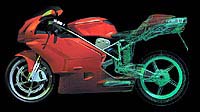
| Home | Music | Gallery | Tengwar | Replay Db | Collision | Prototype |
|
Ducati Evolution The Ducati 999 Source Ducati.com The Testastretta is the latest evolution of the Desmodromic engine. Compared to the previous generation Desmoquattro, the new Ducati 999 engine incorporates multiple improvements including a completely redesigned crankshaft, cylinders, and cylinder heads.  The Testastretta was first introduced in the 996 R and was raced successfully in Superbike competition. Since then the Testastretta has undergone extensive testing, development, and refinement.  The heads have a steep included valve angle of only 25 degrees; 12 degrees for the intake valves and 13 degrees for the exhaust valves. This allows a very compact combustion chamber, and enables the use of flat top pistons while still having a high compression ratio of 11,4:1. Flat top pistons are the optimal choice for efficient combustion because they create the best environment for a smooth and linear flame front. The intake and exhaust valves have increased in diameter to 40 mm and 33 mm, respectively. The Testastretta's desmodromic timing system has evolved significantly with improvements in the design of components and the use of advanced surface treatments, which result in longer maintenance intervals for the valve-train. The stroke of the Testastretta engine in the 999 is 63.5 mm. The shorter stroke lowers the average speed of the piston resulting in a higher RPM redline, maximum performance, and improved reliability. In addition, the lubrication circuit was engineered and developed directly from Ducati's extensive racing experience. A new deep sump is integrated into the engine casing, which ensures constant oil pick-up even when the motorcycle is accelerating aggressively or cornering at extreme lean angles. A revolutionary exhaust system The exhaust system and single-muffler have an innovative non-symmetrical layout. The paths of the manifolds and the high-volume single-muffler have resulted in a significant improvement in torque at the middle of the RPM range. Since the L-twin engine configuration uses exhaust pipes of different lengths, the front pipe diameter increases from 45 to 55 mm compared to the constant 45 mm diameter of the rear pipe to equalize pulse waves and back pressure. The Testastretta used on Ducati 999 is in compliance with Euro 1 clean air standards regulation and is expected to comply as well with the forecasted Euro 2 which is still not defined at the present moment. The air-intake system The challenge of allowing enough air to the engine while keeping intake noise low has been accomplished by increasing the airbox volume to 12.5 liters and by fitting the fresh air intake tracts with a Helmotz resonator to reduce intake noise without sacrificing performance. Fuel injection and engine control The Ducati 999 has a fuel injection system that is directly derived from Ducati Corse race bikes. An advanced 5.9 M CPU engine control unit developed by Magneti Marelli controls the functions of the engine electrical circuit and the ignition system. |
| ||||||||
|
Copyright © 2004 Tacet Blue. All rights reserved. |
||||||||||